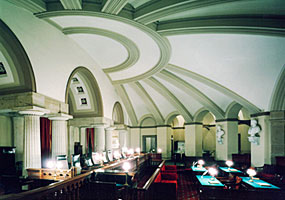Americanos querem sessões da Suprema Corte na TV
15 de março de 2010, 18h24

O que é bom para o Brasil, pode ser bom para os Estados Unidos. Para 60% dos americanos, as sessões da Suprema Corte dos Estados Unidos deveriam ser transmitidas pela televisão, o que seria um avanço na democracia. A experiência de levar ao público os debates da mais alta corte do país, que já é prática no Brasil desde 2002, é defendida em editorial pelo New York Times, o mais prestigioso jornal daquele país.
No editorial, é lembrado que desde 1988, o canal C-Span vem insistindo com a Suprema Corte para transmitir seus debates. O canal costuma transmitir discussões do Congresso e as entrevistas coletivas concedidas pelos ocupantes da Casa Branca. Mas, na Suprema Corte, só teve sucesso em pedidos específicos e de maneira relativa. Em 2000, obteve as fitas de áudio da sessão em que foi julgada a ação contestando a vitória de George Bush sobre Al Gore nas eleições presidenciais. Em 2003 obteve apenas o áudio das discussões sobre a adoção de políticas afirmativas na Universidade de Michigan.
Segundo o Times, “as câmeras na corte permitiriam aos americanos ver com seus próprios olhos, como funciona uma parte extremamente poderosa de seu governo. Permitiria também que os eleitores avaliassem a qualidade dos ministros que o presidente da República nomeia”.
O jornal, constata e lamenta, no entanto, que a tendência entre os integrantes da corte é muito mais pelo fechamento do que pela abertura das sessões. E lembra que em decisão recente, eles proibiram a colocação no YouTube das gravações do julgamento por uma corte inferior de uma ação questionando o casamento entre pessoas do mesmo sexo.
[Foto: Supremecourtus.gov]
Leia o editorial do New York Times (em inglês)
Your Reality TV
In a new poll, more than 60 percent of respondents said televising Supreme Court proceedings would be good for democracy. We agree, but the court seems determined to keep its work out of the public’s eye.
Since 1988, C-Span — which broadcasts Congressional debates, White House news conferences, think tank panels, and all manner of Washington necessities and some oddities — has been asking the Supreme Court for access. The court has consistently refused. When the cable network asked for permission to broadcast the arguments in Bush v. Gore in 2000, the court agreed only to release audiotapes after the fact. In the big University of Michigan affirmative action case of 2003, the court again only released audiotapes.
Cameras in the court would allow Americans to see for themselves how an extremely powerful part of their government works. They would also allow voters to hold presidents accountable for the quality of justices they nominate. Right now, we see the justices during their confirmation hearings and rarely after that.
Opponents of televising the lower courts argue — unpersuasively, in our opinion — that cameras could deprive defendants of a fair trial by intimidating witnesses and jurors. None of those concerns apply to the Supreme Court, where there are no witnesses or jurors. The main objections are the justices’ own concerns about privacy and a vague assertion that televising proceedings would somehow diminish the court. In the new poll by New Jersey’s Fairleigh Dickinson University, only 26 percent of respondents believed that cameras would undermine the court’s authority and dignity.
Rather than opening up, the court has shown signs of turning further inward. After President Obama, in his State of the Union address, criticized the court’s recent ruling on corporate campaign spending, Chief Justice John Roberts questioned whether the justices should continue to attend the event. In January, the justices blocked a lower court from allowing trial video from a challenge to Proposition 8, California’s anti-gay- marriage initiative, to be broadcast on YouTube.
Last fall, Senator Arlen Specter, Democrat of Pennsylvania, introduced a “sense of the Senate” resolution urging the court to permit cameras. The Senate should pass the resolution to prod the court into the 21st century. If the justices still resist, Congress should pass a law requiring that the court’s proceedings be televised.
Encontrou um erro? Avise nossa equipe!


